Ivan Toth Depeña
Ivan Toth Depeña is a Hispanic-American artist currently based in Charlotte, NC, after having lived and worked in Miami, FL, and New York, NY. With a master's Degree in Architecture from Harvard University’s Graduate School of Design, Depeña’s artistic production is informed by his experience in art, architecture, technology, and design and encompasses a range of media.
Depeña has been working increasingly in the public realm and maintains a rigorous, self-directed studio practice. He has exhibited extensively, nationally and internationally, in both solo and group exhibitions, including at the McColl Center, NC; Praxis NY, NYC; New Britain Museum of American Art, CT; Miami Art Museum, Frost Art Museum, and the Museum of Contemporary Art, North Miami. Depeña has recently completed large-scale public commissions in New York, NY; Denver, CO; Albuquerque, NM; Gainesville, and Miami, FL. His work is held in numerous public and private collections.
Ivan has won Public Art of the Year for various projects from Americans for the Arts and the Public Art Network. In early 2014, he was awarded a prestigious Knight Arts Challenge Miami Grant for his proposal for a first of its kind series of augmented reality public art projects throughout South Florida called “Lapse”. Depeña was also a finalist for the renowned Cisneros Fontanals Art Foundation (CIFO) Grants & Commissions program for Hispanic artists for 2017-2018. In addition, he received a nomination for the prestigious United States Artist grant in 2017.
Website
Artist Statement:
When put very simply, the “Hybrid Painting” series is a reflection on random images, time and an attempt at representing the complexity of a serendipitous moment. These in particular are a study of sequence and a rumination on the tectonics of an image in the age of digital reproduction.
They mostly start with photography. Images blended with one another, resulting in a textile of media and technique. In essence a refutation of linearity or a simple back and forth between eye, hand and machine. I suppose it might be like opening a bin of your own past via images found at a second hand store in a future life. Or possibly an exploration of my obsession and compulsion with minutia and the insignificant. A deep dive through the meaninglessness into the meaningful.
Digital photography. Layered and manipulated. Archival pigment print on canvas. Mounted on wood. Visceral reactions. Mark making. Accentuations. Falling into fragmentation and dissolution. Disturbing color, composition and embracing dissonance. Finding harmony. Waiting until the micro universes reveal themselves. Pen plotting specific cartographic responses. Painting emotive reactions. Silk screening intentionality and texture. Analog into digital into analog and back again. Unrelated. Related. Layering. Sealing. Closing.
These images will never be finished. A quantum snapshot. Our reality resembles ants that continue to march, live, reproduce, die and live again. The “Hybrid Paintings” are metaphorical snakes eating their tails.
Am I awake and daydreaming or dreaming that I am awake? It is all data.
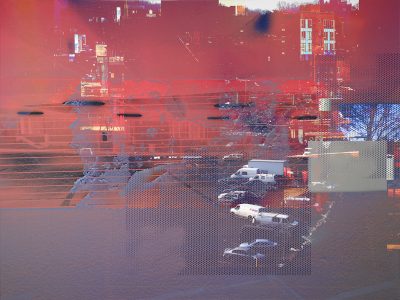
Ivan Toth Depeña
Untitled (9th Street Brooklyn)
Photo/Painting Hybrid
Archival Pigment Print, various inks and enamel on wood

Richard Garet
Perceptual; Star
Moving Image Installation (silent)
Dimensions: 55-60” HD monitor or above
Duration: 44’13”
Richard Garet
Richard Garet is a contemporary multimedia artist born in Montevideo, Uruguay in 1972. He holds an MFA from Bard College, NY. Garet has lived and worked in the United States since 1996. He explores the ontological relationship between the materials he uses, such as background noise activations, image and sound generative processes, and experiments applied to obsolete and current technological media utilities that emulate everyday situations resulting in abstractions. For Garet, these conceptual and experimental creations embody the perception of contemporary life as a filtered and sensory experience.
Richard Garetís work has been awarded nationally and internationally by institutions such as South Florida Cultural Consortium, FL; Prix Ars Electronica, Linz; Ministry of Education and Culture of Uruguay; CIFO Grants & Commissions Program, FL; The Clocktower, NYC; Foundation of Contemporary Arts, NYC; Issue Project Room, NYC; New York State Council of the Arts, NYC; and Taliesin West, The Frank Lloyd Wright School of Architecture, Scottsdale, Arizona.
Website
Artist Statement:
Perceptual Series stands as an exploration at the intersection of contemporary technology and artistic innovation, reshaping the landscape of painting, light and space art, and soundscapes through a series of mesmerizing moving image compositions.
Within the Perceptual Series, each of the 31 works is a carefully crafted visualization of sonic constructions, with sound serving as both a material tool and an instrument. Garet's precise handling of sound material enables him to craft immersive soundscapes that propel his visual explorations forward. However, in a bold departure, Garet strips away the auditory component, leaving viewers with only the moving image signal. Through this deliberate removal of sound, the true essence of Garet's vision emerges: an invitation for viewers to embark on an optical journey through intricate soundscapes, where visuals dynamically shift and morph in response to the properties of the sonic composition.
His approach revitalizes traditional forms, transcending the limitations of conventional painting through the innovative use of contemporary technology. By harnessing algorithmic processes and generative techniques, Garet opens up new realms of creative exploration, where light, space, and color converge to redefine the very essence of artistic expression.
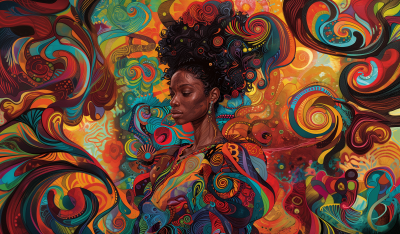
Nettrice Gaskins
Afro-Generative Tableaux Variations
AI
Dimensions variable
Nettrice Gaskins
Dr. Nettrice R. Gaskins is an African American digital artist, academic, cultural critic and advocate of STEAM fields. In her work she explores "techno-vernacular creativity" and Afrofuturism. Dr. Gaskins teaches, writes, "fabs”, and makes art using algorithms and machine learning. She has taught multimedia, visual art, and computer science with high school students. She earned a BFA in Computer Graphics with Honors from Pratt Institute in 1992 and an MFA in Art and Technology from the School of the Art Institute of Chicago in 1994. She received a doctorate in Digital Media from Georgia Tech in 2014.
Currently, Dr. Gaskins is a 2021 Ford Global Fellow and the assistant director of the Lesley STEAM Learning Lab at Lesley University. She is an advisory board member for the School of Literature, Media, and Communication at Georgia Tech. Her first full-length book, Techno-Vernacular Creativity and Innovation is available through The MIT Press. Gaskins' AI-generated artworks can be viewed in journals, magazines, museums, and on the Web. Her series of 'featured futurist' portraits are on view at the Smithsonian Arts and Industries Building through early July 2022.
Gaskins served as Board President of the National Alliance for Media Arts and Culture (The Alliance) and she was on the board of the Community Technology Centers Network (CTCNet) and Artisan’s Asylum.
Website
https://www.nettricegaskins.com
Artist Statement
Nettrice Gaskins used image and text prompts in Midjourney to describe what she wanted the AI image generator to create. She used the Pan and Vary (Region) options in Midjourney to expand and remix the canvas of the image without changing the content of the subject. The newly expanded canvas is filled in using guidance from the artist’s prompt and the original image. Thus, the main subject remains in the center while the tool pushes the borders left and right to tell more of the story. Several iterations from this process were used by the artist to create the frame-by-frame animation.
Nettrice Gaskins used image and text prompts in Midjourney to describe what she wanted the AI image generator to create. She used the Pan and Vary (Region) options in Midjourney to expand and remix the canvas of the image without changing the content of the subject. The newly expanded canvas is filled in using guidance from the artist’s prompt and the original image. Thus, the main subject remains in the center while the tool pushes the borders left and right to tell more of the story. Several iterations from this process were used by the artist to create the frame-by-frame animation.
Ira Greenburg
Ira Greenburg My practice includes computation (creative coding, AI), drawing, and painting. Regardless of medium, my process is primarily generative/emergent. I begin most often automatically, with no target/goal/outcome in mind; my hands begin coding/drawing/prompting/painting. Hopefully, something engaging reveals itself along the way. I define my overall process as post-computational, in that it is deeply informed by many years of coding. (I think of embodied algorithms when holding a pencil/paintbrush.) I do not aspire to align myself with any single creative/aesthetic/art historical tradition. Yet, I deeply appreciate craft and visual literacy and also disruptive technologies.’
With an eclectic background combining studio & applied arts and computer science, Ira Greenberg has been a painter, 2D & 3D animator, print designer, web & interactive designer/developer, programmer, art director, creative director, managing director, art & computer science professor, author and web3 Co-founder. He wrote the first major language reference on the Processing programming language, Processing: Creative Coding and Computational Art, (Berkeley, CA: friends of ED, 2007) and two subsequent creative coding texts. Greenberg holds a B.F.A. from Cornell University and a M.F.A. from the University of Pennsylvania.
Greenberg has steadily exhibited his work, consulted within industry and lectured widely throughout his career. He was affiliated with the Bowery Gallery in New York City, Flywheel Gallery in Piermont, NY, and Strata Gallery in Santa Fe, NM. He was a managing director and creative director for H2O Associates in New York’s Silicon Alley, where he helped build a new media division during the original dot-com boom and then bust, barely parachuting back to safety in the ivory tower. Since then, he has been inciting students to create inspirational new media art, lecturing at numerous institutions, including Trinity College (Dublin, Ireland); University of Edinburgh (UK); University of Iowa; University of Northern Iowa; Seton Hall University; Monmouth University; University of California, Santa Barbara; Kutztown University; Moravian College; Lafayette College; Lehigh University; the Art Institute of Seattle; Studio Art Centers International (Florence, Italy); City and Guilds of London Art School (UK), and Goldsmiths, University of London.
Currently, Greenberg is Director of the Center of Creative Computation and Professor at SMU, with a joint appointment in the Meadows School of the Arts and the Lyle School of Engineering. Previously, he was Associate Professor at Miami University (Ohio), where he held a joint appointment within the School of Fine Arts and Interactive Media Studies program and was an affiliate member of the Department of Computer Science and Systems Analysis.
Website
Artist Statement
As a painter, the residue of the medium and process is an inherent characteristic to the physical material. As one advances in the craft, one learns to appreciate, even cherish, these procedural artifacts that take on a life of their own, manifestations of less conscious impulses. These material gems often carry a special weight and resonance in the work; think of the scumbling on the face of a Rembrandt self-portrait, or the peripatetic tracings in a Giacometti painting. For a long time, I’ve thought about how physical artifacts manifest in the digital, often jocularly referring to such phenomena as code drippings.
I began prompting, for what would become ‘CyberStructures’, thinking about computer architectures as vast landscapes: circuitry, roadways, components, buildings and structures. There were whimsical explorations as well that became past projects: ‘Ancient Automata’, Bright Moments, Venice CA, July 22, 2023 and ‘Machinations:CandyPuter.OE’, Objkt.com, July 5, 2023. My original name for this collection was ‘CyberCities’, with my initial impulse to generate as much scale and complexity as I could conjure out of the AI. This exploration went on for months, through thousands of iterations.
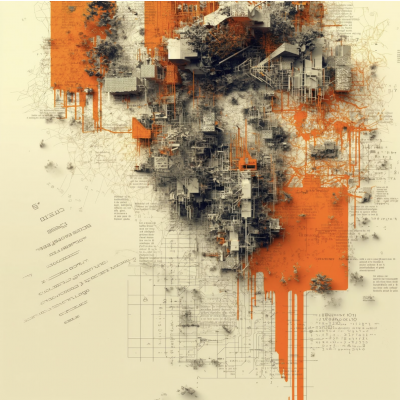
Ira Greenburg
CyberStructures
AI
2024
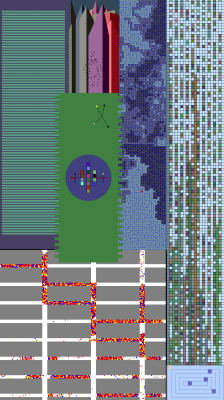
John F Simon Jr.
Traffic Jam
Custom Software/Video
Hardware and dimensions variable
John F. Simon Jr
John F Simon, Jr. is an author and Software Art pioneer whose works are found in the permanent collections of The Whitney Museum of American Art, The Solomon R. Guggenheim Museum, and The Museum of Modern Art in New York, among others. In 2011, he collaborated with Icelandic singer Björk to write an app for her album, Biophilia. In 2023, an NFT from his critically acclaimed collection, Every Icon, was one of the first NFTs acquired by the Pompidou Center. Simon's book, "Drawing Your Own Path: 33 Practices at the Crossroads of Art and Meditation" came from his decades long daily drawing practice that is maintained on iclock.com.
Drawing is the one thing I must do every day. I have made daily drawings for over 25 years. The drawings are sketches, designs, therapy, entertainment, and a basic need to express something. I make up stories about them. I make larger drawings and sculptures from them. They outline the structures for my software compositions and now I use them as style guides for AI drawings.
When I draw, I improvise, with no idea what will appear. I allow my hand to move and reveal something new. I feel a similar sense of discovery when I explore software art - sharing the creative discovery with an algorithm. My code allows me to discover complexity and variation beyond what I can imagine.
Website
Artist Statement
ComplexCity explores contemporary urbanism through animated visual outputs containing abstract elevators, clogged intersections, and other interactive and dynamic forms. First exhibited as a physical artwork as both hardware and software in 2000 (and acquired by LACMA in 2001), ComplexCity has been described by John F. Simon, Jr. as his most autobiographical and representational artwork.
Concerned with the “realism of abstraction”, ComplexCity’s aesthetics investigate Mondrian’s iconic pure abstraction in Broadway Boogie Woogie (1942-1943), and the abstract realism of Stuart Davis. These lush and frenetic digital representations of the city, skylines, skyscrapers and traffic flows are imbued with the optimism and possibilities of a new millennium.
Two decades after its original publication, Simon launched an updated generative on-chain collection of the software, ComplexCity NFT (2023) Simon’s updates generated new iterations and collages of ComplexCity using six templates that vary in composition, interactivity and rarity. Similar to his earlier physical pieces, these tokens are not videos but software that creates constantly changing, never repeating animations.
Courtney Starrett and Susan Reiser
Courtney Starrett is an associate professor at Texas A&M University in the Department of Visualization and holds the Harold L. Adams ‘61 Interdisciplinary endowed Professorship in Visualization. Her work has been exhibited nationally and internationally, is included in permanent collections at the Mint Museum Uptown in Charlotte, NC, and Center for Contemporary Art & Culture at Pacific Northwest College of Art in Portland, OR, and has been published in print in periodicals and books such as Metalsmith Magazine, How Design Magazine, Taiwan Craft Magazine, Art Jewelry Magazine, Cast: Art and Objects, 500 Necklaces, and 500 Plastic Jewelry Objects. Starrett’s innovative design workflow utilizing data as a raw material as a base for the design of 3-dimensional objects, data materialization, has been published in a leading journal on the application of science and technology to arts and music: Leonardo (MIT Press) and cited in forthcoming the Handbook on Human-Computer Interaction (Springer; 1st ed.2023) chapter on Data Physicalization (Dragicevic, Jansen, and Vande Moere, 2019). Starrett has served as an ACM SIGGRAPH volunteer on conference planning committees and subcommittees for more than a decade in roles such as the 2014 Studio chair, the 2019 Emerging Technologies chair, 2022 Community Engagement chair, 2023 SIGGRAPH Labs chair, and is currently serving on the ACM SIGGRAPH Executive Committee.
Website:
http://www.courtneystarrett.com
Susan Resier I work at the exciting intersection of computer science and art, developing software and creating data materialization. I thoroughly enjoy the creativity inherent in user-centered design and fabrication, and try to convey that to my students. Before teaching at UNC Asheville, I worked in industry as a software developer and systems engineer. In addition to corporate work, I developed visualization applications for Duke Cardiology's Electrophysiology Lab.
Website
https://www.unca.edu/person/susan-reiser/
Artist Statement:
Equal but Different was designed to commemorate the 100th anniversary of the 19th Amendment, a landmark legislation that secured the right to vote for American women. The design drew upon statistical data regarding the race and gender of the 116th U.S. Congress, which was the most diverse Congress in history. Notably, this Congress had 22% of its members identified as racial or ethnic minorities, a significant increase in diversity from previous Congresses. Data from the Center for American Women and Politics served as the basis for a custom computer script. This script generated an array of circles with varying diameters, each circle representing a data point. After refining and editing the pattern, a drawing was created for waterjet cutting from a steel sheet. The cut steel pattern was subsequently hand-forged into baskets. These forms represent the progress made by minorities and women over the past century. The negative space in the design symbolizes the ongoing work needed to ensure all individuals are recognized, treated equally, and respected as valuable members of society. The project highlights the importance of having more diverse leaders and fostering a society that values our differences.

Courtney Starrett with Susan Reiser
Equal but Different
Steel and demographic (race and gender) composition of the 116th US Congress
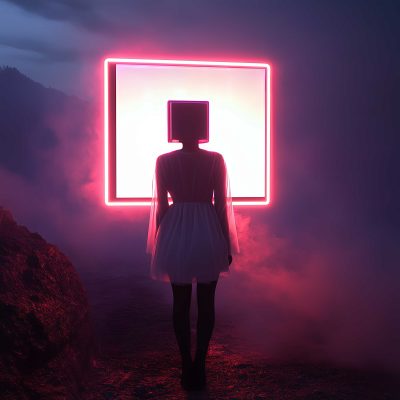
Tiffany Trenda
Beyond Performance
Video
Tiffany Trenda
Tiffany Trenda is a performance and new media artist based in Los Angeles, with a career spanning over two decades. Her performances have been presented at prestigious venues, including the Broad Art Museum, the World Expo in Shanghai, Architecture + Design Museum, Boulder Museum of Contemporary Art, the Los Angeles County Museum of Art, and the Exploratorium: The Museum of Science, Art & Human Perception. Notably, she was featured in the performance program of Metamorphoses of the Virtual during the 55th Venice Biennale. Trenda's work has also been exhibited at the Faena Art Center in Buenos Aires in the acclaimed show Auto Body and in the special projects section of Context Art Miami. More recently, her art has exhibited at Laboratorio Arte Alameda in Mexico City, Art Center Nabi in South Korea, Brand Library and Art Center, and Art in Flux at the Barbican in London. Additionally, her pieces are part of the permanent collections at the Scottsdale Museum of Contemporary Art and Beinecke Library at Yale University. Trenda holds a BFA from Art Center College of Design and an MFA from UCLA's Design and Media Arts program.
Tiffany Trenda's work engages with the intersection of the human body and emerging technologies. Rooted in performance and new media, her practice navigates the shifting boundaries between the real and the virtual, prompting viewers to confront the evolving concepts of identity and embodiment in today’s increasingly digital landscape. Trenda challenges the way our presence is mediated by technology, urging us to reconsider the ways we experience and understand the world around us.
Her work investigates how technology is transforming our phenomenological understanding of the body and material reality. She focuses on the subtleties of human experience as mediated through digital constructs, creating a conversation that blurs the lines between traditional and future mediums. Trenda’s practice opens a conversation between human subjectivity and machine perception, encouraging reflection on the ever-evolving relationship between the body, technology, and materiality in the digital age.
Website
Artist Statement:
“In Beyond Performance, Trenda ventures into the realm of performance art and artificial intelligence. Through the integration of smart applications and her performance archive of over two decades, she introduces a new dimension to the traditional understanding of the body in performance art. These imaginative performances only exist in the digital realm, blurring the boundaries between what is real and what is fictional. These imagined performances push the limits of what can be, challenging conventional notions of identity and representation within simulated experiences.
This work invites viewers to contemplate the fluidity of meaning and the interplay between machine perception-how artificial intelligence interprets the performance art data set - and human subjectivity. They offer a lens through which we can understand and navigate the complexities of the body in the digital age.” Holly Willis, University of Southern California